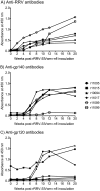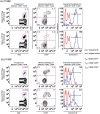A recombinant herpesviral vector containing a near-full-length SIVmac239 genome produces SIV particles and elicits immune responses to all nine SIV gene products
- PMID: 29912986
- PMCID: PMC6023237
- DOI: 10.1371/journal.ppat.1007143
A recombinant herpesviral vector containing a near-full-length SIVmac239 genome produces SIV particles and elicits immune responses to all nine SIV gene products
Abstract
The properties of the human immunodeficiency virus (HIV) pose serious difficulties for the development of an effective prophylactic vaccine. Here we describe the construction and characterization of recombinant (r), replication-competent forms of rhesus monkey rhadinovirus (RRV), a gamma-2 herpesvirus, containing a near-full-length (nfl) genome of the simian immunodeficiency virus (SIV). A 306-nucleotide deletion in the pol gene rendered this nfl genome replication-incompetent as a consequence of deletion of the active site of the essential reverse transcriptase enzyme. Three variations were constructed to drive expression of the SIV proteins: one with SIV's own promoter region, one with a cytomegalovirus (cmv) immediate-early promoter/enhancer region, and one with an RRV dual promoter (p26 plus PAN). Following infection of rhesus fibroblasts in culture with these rRRV vectors, synthesis of the early protein Nef and the late structural proteins Gag and Env could be demonstrated. Expression levels of the SIV proteins were highest with the rRRV-SIVcmv-nfl construct. Electron microscopic examination of rhesus fibroblasts infected with rRRV-SIVcmv-nfl revealed numerous budding and mature SIV particles and these infected cells released impressive levels of p27 Gag protein (>150 ng/ml) into the cell-free supernatant. The released SIV particles were shown to be incompetent for replication. Monkeys inoculated with rRRV-SIVcmv-nfl became persistently infected, made readily-detectable antibodies against SIV, and developed T-cell responses against all nine SIV gene products. Thus, rRRV expressing a near-full-length SIV genome mimics live-attenuated strains of SIV in several important respects: the infection is persistent; >95% of the SIV proteome is naturally expressed; SIV particles are formed; and CD8+ T-cell responses are maintained indefinitely in an effector-differentiated state. Although the magnitude of anti-SIV immune responses in monkeys infected with rRRV-SIVcmv-nfl falls short of what is seen with live-attenuated SIV infection, further experimentation seems warranted.
Conflict of interest statement
The authors have declared that no competing interests exist.
Figures









Similar articles
-
Recombinant Herpesvirus Vectors: Durable Immune Responses and Durable Protection against Simian Immunodeficiency Virus SIVmac239 Acquisition.J Virol. 2021 Jun 24;95(14):e0033021. doi: 10.1128/JVI.00330-21. Epub 2021 Jun 24. J Virol. 2021. PMID: 33910957 Free PMC article.
-
Vaccine protection against SIVmac239 acquisition.Proc Natl Acad Sci U S A. 2019 Jan 29;116(5):1739-1744. doi: 10.1073/pnas.1814584116. Epub 2019 Jan 14. Proc Natl Acad Sci U S A. 2019. PMID: 30642966 Free PMC article.
-
Vaccine protection against simian immunodeficiency virus in monkeys using recombinant gamma-2 herpesvirus.J Virol. 2011 Dec;85(23):12708-20. doi: 10.1128/JVI.00865-11. Epub 2011 Sep 7. J Virol. 2011. PMID: 21900170 Free PMC article.
-
A Recombinant Rhesus Monkey Rhadinovirus Deleted of Glycoprotein L Establishes Persistent Infection of Rhesus Macaques and Elicits Conventional T Cell Responses.J Virol. 2020 Jan 6;94(2):e01093-19. doi: 10.1128/JVI.01093-19. Print 2020 Jan 6. J Virol. 2020. PMID: 31645449 Free PMC article.
-
CD8 T Cells Show Protection against Highly Pathogenic Simian Immunodeficiency Virus (SIV) after Vaccination with SIV Gene-Expressing BCG Prime and Vaccinia Virus/Sendai Virus Vector Boosts.J Virol. 2021 Jan 28;95(4):e01718-20. doi: 10.1128/JVI.01718-20. Print 2021 Jan 28. J Virol. 2021. PMID: 33087465 Free PMC article.
Cited by
-
The Frequency of Vaccine-Induced T-Cell Responses Does Not Predict the Rate of Acquisition after Repeated Intrarectal SIVmac239 Challenges in Mamu-B*08+ Rhesus Macaques.J Virol. 2019 Feb 19;93(5):e01626-18. doi: 10.1128/JVI.01626-18. Print 2019 Mar 1. J Virol. 2019. PMID: 30541854 Free PMC article.
-
Vaccine protection against rectal acquisition of SIVmac239 in rhesus macaques.PLoS Pathog. 2019 Sep 30;15(9):e1008015. doi: 10.1371/journal.ppat.1008015. eCollection 2019 Sep. PLoS Pathog. 2019. PMID: 31568531 Free PMC article.
-
RhCMV serostatus and vaccine adjuvant impact immunogenicity of RhCMV/SIV vaccines.Sci Rep. 2020 Aug 20;10(1):14056. doi: 10.1038/s41598-020-71075-x. Sci Rep. 2020. PMID: 32820216 Free PMC article.
-
Recombinant Herpesvirus Vectors: Durable Immune Responses and Durable Protection against Simian Immunodeficiency Virus SIVmac239 Acquisition.J Virol. 2021 Jun 24;95(14):e0033021. doi: 10.1128/JVI.00330-21. Epub 2021 Jun 24. J Virol. 2021. PMID: 33910957 Free PMC article.
-
Vaccine protection against SIVmac239 acquisition.Proc Natl Acad Sci U S A. 2019 Jan 29;116(5):1739-1744. doi: 10.1073/pnas.1814584116. Epub 2019 Jan 14. Proc Natl Acad Sci U S A. 2019. PMID: 30642966 Free PMC article.
References
-
- Desrosiers RC. Strategies used by human immunodeficiency virus that allow persistent viral replication. Nat Med. 1999;5:723–725. doi: 10.1038/10439 - DOI - PubMed
-
- Desrosiers RC. Prospects for an AIDS vaccine. Nat Med. 2004;10:221–223. doi: 10.1038/nm0304-221 - DOI - PubMed
-
- Evans DT, Desrosiers RC. Immune evasion strategies of the primate lentiviruses. Immunol Rev. 2001;183:141–158. - PubMed
-
- Piantadosi A, Chohan B, Chohan V, McClelland RS, Overbaugh J. Chronic HIV-1 infection frequently fails to protect against superinfection. PLoS Pathog. 2007;3:e177 doi: 10.1371/journal.ppat.0030177 - DOI - PMC - PubMed
-
- Almond N, Kent K, Cranage M, Rud E, Clarke B, Stott EJ. Protection by attenuated simian immunodeficiency virus in macaques against challenge with virus-infected cells. Lancet. 1995;345:1342–1344. - PubMed
Publication types
MeSH terms
Substances
Grants and funding
LinkOut - more resources
Full Text Sources
Other Literature Sources
Research Materials

